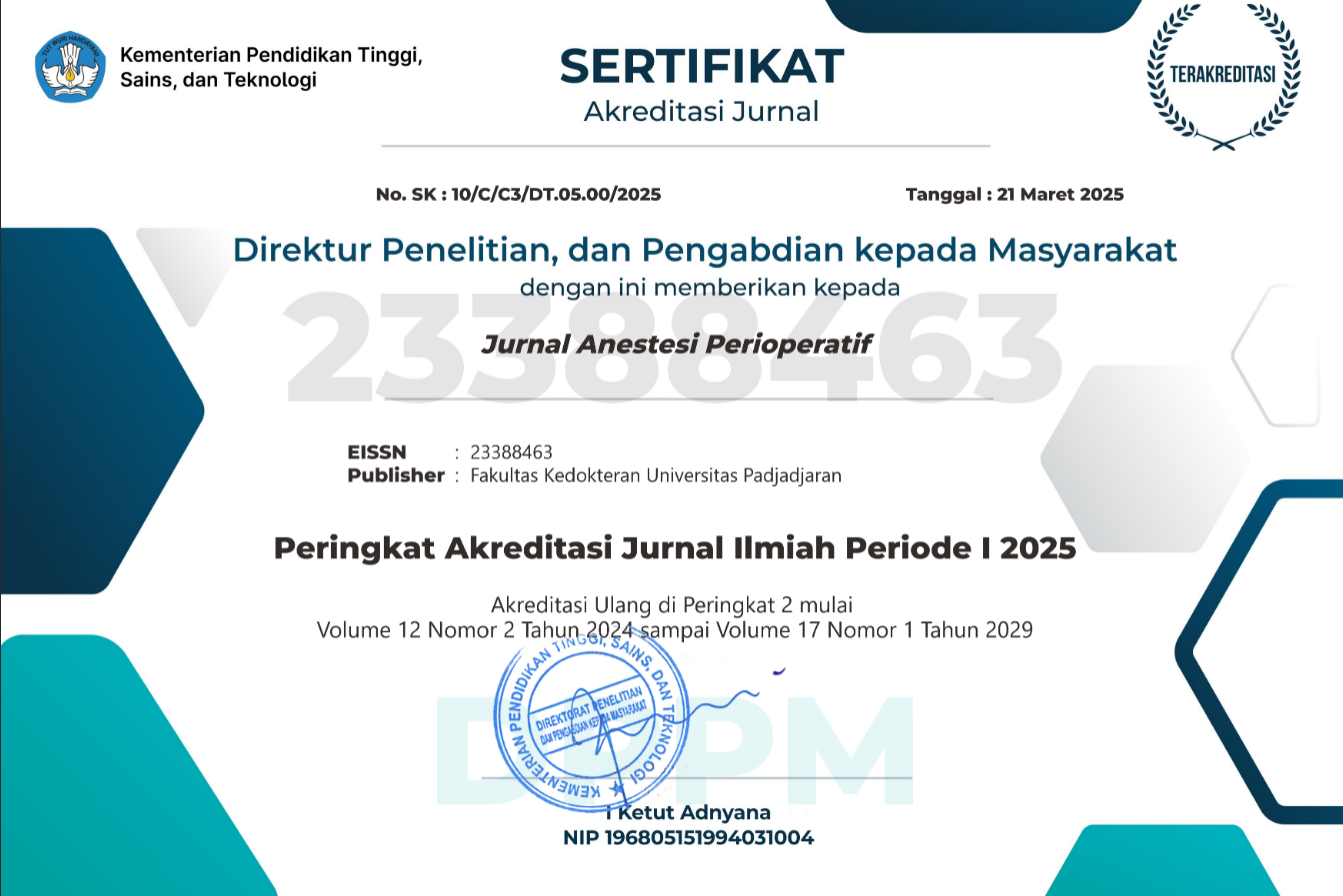Perbedaan Efek Tramadol Infus Kontinu dengan Bolus Intermiten terhadap Numeric Rating Scale (NRS) Pasien Pascamultipel Odontektomi
Abstract
Penggunaan tramadol bolus berulang secara teratur atau sesuai dengan permintaan adalah bentuk administrasi analgesia dalam terapi nyeri pascaoperasi. Penelitian ini bertujuan membandingkan efek tramadol infus kontinu dengan bolus intermiten terhadap numeric rating scale pascamultipel odontektomi. Penelitian ini dilaksanakan RSUD Dr. Moewardi, Surakarta dan RSUD KET Setjonegoro, Wonosobo mulai bulan September–November 2018 menggunakan uji klinik acak tersamar tunggal pada 36 pasien yang dilakukan multipel odontektomi dan memenuhi kriteria inklusi. Sampel dibagi menjadi 2 kelompok, yaitu kelompok I tramadol bolus awal 100 mg selanjutnya infus kontinu 0,25 mg/kg/jam ditambah parasetamol 500 mg/8 jam bolus dan kelompok II tramadol bolus awal 100 mg, selanjutnya 50 mg/8 jam bolus ditambah parasetamol 500 mg/8 jam. Semua pasien mendapatkan perlakuan anestesi umum sesuai dengan standar dan kemudian dilakukan penilaian skala nyeri jam ke-2, 6, 12, 24 pascaoperasi. Selain itu juga dinilai efek mual muntah pascaoperasi. Hasil uji statistik didapatkan nilai p=0,240 (p>0,05) jam ke-2, p=0,007 (p<0,05) jam ke-6, p=0,658 (p>0,05) jam ke-12, p=0,219 (p>0,05) jam ke-24 yang berarti terdapat perbedaan signifikan NRS pada jam ke-6 pascaoperasi antara kelompok I dan II. Hasil uji statistik didapatkan nilai p=0,743 (p>0,05) yang berarti tidak terdapat perbedaan efek samping mual-muntah pascamultipel odontektomi pada kedua kelompok. Simpulan, terdapat perbedaan efektivitas analgetik yang diukur dengan NRS pascamultipel odontektomi dengan diberikan tramadol infus kontinu dibanding dengan tramadol bolus intermiten pada 6 jam pascaoperasi.
Differences of Continuous Infusion and Intermittent Tramadol Effect on Numeric Rating Scale in Post Multiple Odontectomy Patients
The use of regular or on-demand repeated bolus tramadol is a form of analgesia administration in the treatment of postoperative pain. This study aimed to find better ways of analgesic administration after multiple odontectomy. This research was conducted in Dr. Moewardi General Hospital, Surakarta, and KET Setjonegoro General Hospital, Wonosobo, from September to November 2018, using a single-blind randomized clinical trial in 36 patients who had multiple odontectomy and met the inclusion criteria. Samples were divided into two groups. Group I received: an initial bolus of tramadol 100 mg, then a continuous infusion of 0.25 mg/kg/hour plus paracetamol 500 mg/8 hours bolus, and group II received initial bolus tramadol 100 mg, then 50 mg/8 hours bolus plus paracetamol 500 mg/8 hours. All patients received standard general anesthetic treatment and then postoperative pain assessment at 2, 6, 12, and 24 hours. Besides, the effects of postoperative nausea were also assessed. Statistical test results p = 0.240 (p>0.05) at the second hour, p = 0.007 (p<0.05) at the 6th hour, p=0.658 (p>0.05) at the 12th hour, p = 0.219 (p>0.05) at the 24th hour, meaning there was a difference in NRS at the 6th hour postoperatively between groups I and II. Statistical test results were p = 0.743 (p> 0.05), meaning there were no differences in the side effects of nausea post multiple odontectomy in the two groups. In conclusion, there is a significant difference in analgesic efficacy as measured by NRS post multiple odontectomy with continuous tramadol infusion compared with intermittent tramadol boluses at the 6th hour postoperatively.
Keywords
Full Text:
PDFReferences
- Taufiqurrachman, Mulyo K. Perbandingan pengaruh pemberian analgetik etoricoxib dengan natrium diclofenak terhadap rasa nyeri pasca odontektomi (impaksi kelas 1, molar 3 rahang bawah). J Kedokt Diponegoro. 2016;5(3):222–34.
- Syaflida, Rahmi. Depiction of post-odontectomy pain levels in universitas Sumatera Utara Hospital period of February-March 2017. Sumatera Utara: Atlantis Press; doi: https://doi.org/10.2991/idcsu-17.2018.62
- Coda BA. Opioids. Dalam:Barash PG, Cullen BF, Stoelting RK, penyunting. Clinical anesthesia. Edisi ke-5. Philadelphia: Lippincott Williams & Wilkins; 2006. hlm. 353–83.
- Widana I. Panduan penggunaan patient controlled analgesia (PCA) dalam penalataksanaan nyeri. Jakarta: ISAPM; 2017.
- Kavishvar NA, Prajapati BH. A comparative study of intravenous patient-controlled analgesia with tramadol alone and tramadol plus dexmedetomidine for major lower abdominal surgery. Indian J Pain 2017;31:107–11.
- Gousheh SM, Nesioonpour S, Javaher Foroosh F, Akhondzadeh R, Sahafi SA, Alizadeh Z. Intravenous paracetamol for postoperative analgesia in laparoscopic cholecystectomy. Anesth Pain Med. 2013;3(1):214–8.
- Sarantopoulos C. pain pathways and mechanisms. Dalam: Abraham SE, penyunting. Pain medicine : the requisites in anesthesiology. Philadelphia: Mosby Elsevier; 2006. hlm 1–3.
- Sastroasmoro S, Ismael S. Dasar-dasar metodologi penelitian klinis. Jakarta: Binarupa Aksara; 2011.
- Gan TJ, Diemunsch P, Habib AS, Kovac A, Kranke P, Meyer TA, dkk. Society for Ambulatory Anesthesia. Consensus guidelines for the management of postoperative nausea and vomiting. Anesth Analg. 2014;118(1):85–113.
- Gan TJ, Belani KG, Bergese S, Chung F, Diemunsh HP, Habib AS, dkk. Fourth consensus guidelines for the management of postoperative nausea and vomiting: Erratum. Anesth Analg. 2020;131(2):411–48.
DOI: https://doi.org/10.15851/jap.v10n3.2489
Article Metrics
Abstract view : 1663 timesPDF - 496 times
This Journal indexed by

JAP is licensed under a Creative Commons Attribution-NonCommercial 4.0 International License
View My Stats



